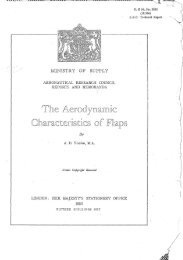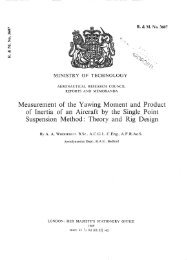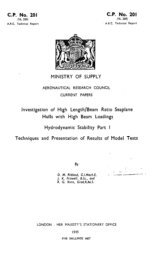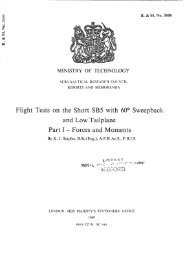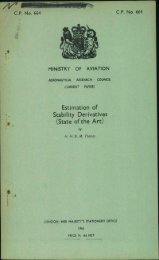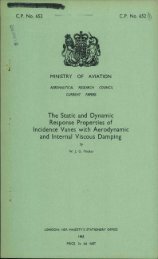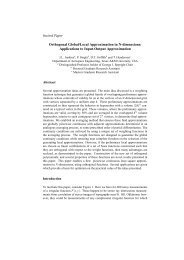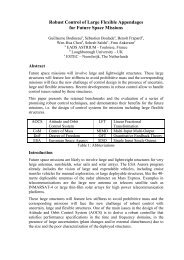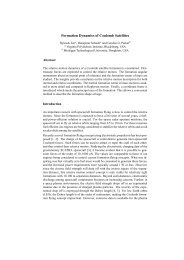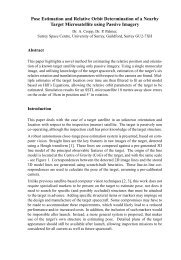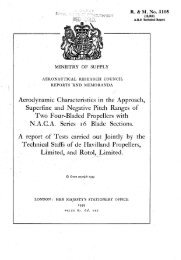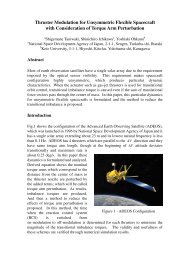A Survey of Unsteady Hypersonic Flow Problems
A Survey of Unsteady Hypersonic Flow Problems
A Survey of Unsteady Hypersonic Flow Problems
Create successful ePaper yourself
Turn your PDF publications into a flip-book with our unique Google optimized e-Paper software.
- 12 -<br />
where W is the weight <strong>of</strong> the vehicle; S is the lifting area; R is the<br />
radius <strong>of</strong> the flight path from the earth's centre. Thus when the speed is<br />
high flight is possible at lower values <strong>of</strong> dynamic pressure than when the speed<br />
is lcw.<br />
The actual limits <strong>of</strong> the flight corridor depend on the design <strong>of</strong> the<br />
vehicle, but Fig. 3 has been prepared to indicate the range <strong>of</strong> flight conditions<br />
within which hypersonic vehicles may normally be expected to operate. The<br />
minimum value <strong>of</strong> the parameter W/XI has been taken to be 15 lb/fta: only<br />
vehicles involving light weight lifting structures are likely to give values .<br />
<strong>of</strong> less than this; and the maximum value <strong>of</strong> dynamic pressure has been taken as<br />
1000 lb/ft'. The lines in Fig. 3 representing the altitudes and speeds for<br />
these constant parameters define a flight corridor in terms <strong>of</strong> minimum lift<br />
and maximum dynamic pressure. Two bands are shown representing the speeds and<br />
altitudes at which the-stagnation temperature will be 2000'R and 4CC9R. A<br />
limit on stagnation temperature <strong>of</strong> 2OOO'R will permit flight in only a restricted<br />
region; a limit <strong>of</strong> 4OCO"R permits a flight corridor extending to orbital speed.<br />
Superimposed on the flight corridors defined by d.ynamiC pressure,<br />
stagnation temperatures and lift in Fig. 3 are shown lines <strong>of</strong> constant Reynolds<br />
number and constant values <strong>of</strong> the viscous interaction parameters, x. The<br />
values <strong>of</strong> Reynolds number per foot that are likely to be met suggest that, at<br />
the higher speeds and altitudes, laminar bcundarg layers will extend over much<br />
<strong>of</strong> the vehicle surface, and flow separations will be more easily provoked than<br />
at lower speeds, where much <strong>of</strong> the boundary layer is turbulent. The parameter<br />
x indioates the importance cf interaotions between the boundary layer and the<br />
external flow and is defined by the equation:<br />
where o, is the constant in the tiscosity relation<br />
CI T<br />
-=ck<br />
-T<br />
m<br />
. . . (1.2)<br />
and is usually close to unity. The value <strong>of</strong> o,,, has been taken as unity in<br />
Fig. 3. Values af x <strong>of</strong> O(O-5) and greater suggest that these interactions<br />
will have significant effects on pressure distributions for sharp-nosed bodies<br />
(Appendix II, Seotion 2.2).<br />
Fig. 4 shows some possible trajectories for super-circular ballistic<br />
re-entry (re-entn velocity is greater than circular orbital velocity), super<br />
circular lifting re-entry, lifting exit, and expandable structure lifting<br />
re-entry (W/SCL < 15): these are superimposed on the flight corridors defined<br />
in Fig. 3. The ballistic trajectory shcws very high values <strong>of</strong> dynamic pressure<br />
and stagnation temperature illustrating the severity <strong>of</strong> the conditions for this<br />
form <strong>of</strong> re-entq which was mentioned before. The super circular lifting re-entzy<br />
trajectory shows a condition <strong>of</strong> high dynamic pressure and stagnation temperature<br />
in the early stages <strong>of</strong> re-entry, when the Mach number is very high, but the<br />
Bfting exit trajectory shows a maximum dynamic pressure below the hypersonio<br />
speed range.<br />
APFEWDIxII/



